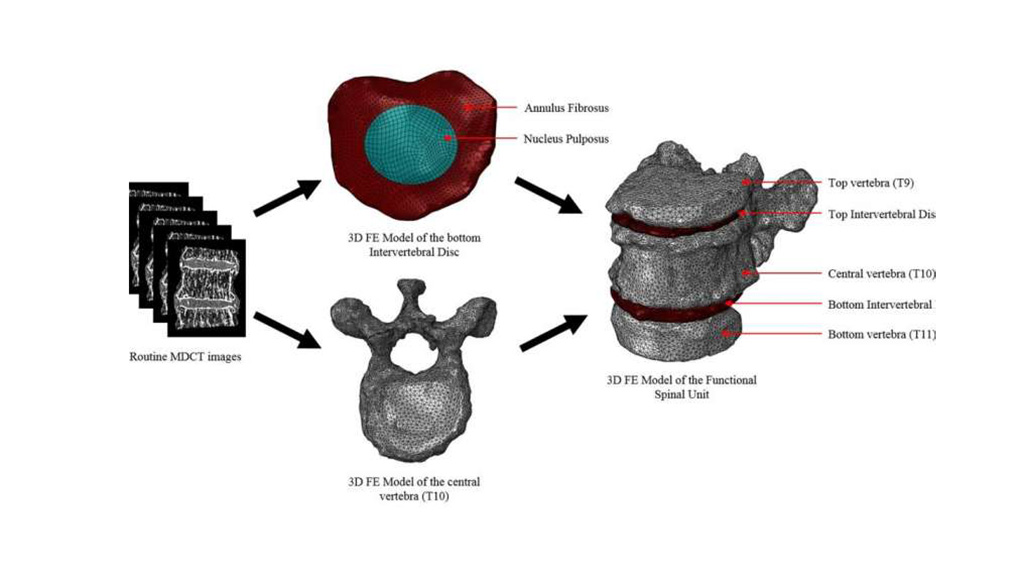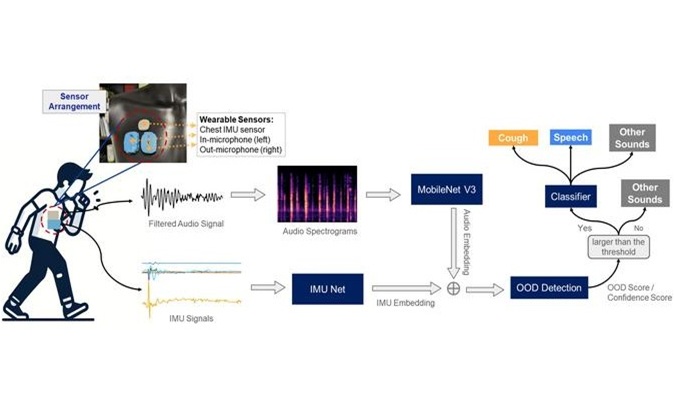Finite Element Analysis Helps Predict Spinal Fractures
|
By HospiMedica International staff writers Posted on 01 Jan 2020 |

Image: Finite analysis can help determine cervical bone strength (Photo courtesy of SUTD)
A new study introduces a novel vertebral strength assessment tool that can assist accurate prediction of osteoporotic vertebral fracture (OVF) risk.
Developed at the Singapore University of Technology and Design (SUTD) and Munich Technical University (TUM; Germany), the semi-automatic computational tool is designed to extract structural information, such as failure load, from radiological scans of patients using functional spinal units (FSUs). The calculated FSU predicted failure load was compared to the bone mineral density (BMD) values of the single central vertebra with experimentally measured failure load in order to assess finite element (FE) correlation.
To do so, the FSUs underwent clinical multi-detector computed tomography (MDCT), and BMD was then determined for the FSUs from the MDCT images of the central vertebrae. FE-predicted failure load was then calculated in the single central vertebra alone, and the entire FSUs. The results revealed that while BMD of the central vertebrae correlated significantly with experimentally measured failure load, the FE-predicted failure load of the central vertebra showed no significant correlation. However, FE-predicted failure load of the FSUs best predicted experimentally measured failure load. The study was published on December 10, 2019, in Spine.
“There is an urgent need to implement computational biomechanical analysis in the clinical scenario, since it is a powerful tool for non-invasive evaluation of bone strength,” said senior author Subburaj Karupppasamy, PhD, of the SUTD Medical Engineering and Design (MED) laboratory. “Accordingly, this work lays the foundation towards extracting valuable structural information from improved spine models, such as FSUs, in the diagnosis of osteoporosis and prediction of OVFs.”
Computational prediction of failure load through numerical simulation, known popularly as FE analysis, is a non-invasive tool for examination of the spine, which also provides a holistic quantitative evaluation of bone strength. As the spine consists of many different spinal segments, it is essential to include these all load-bearing segments when considering the structural strength of spine. FSUs have the advantage of mimicking the biomechanical requirements of the spine better than each isolated vertebral segment.
Related Links:
Singapore University of Technology and Design
Munich Technical University
Developed at the Singapore University of Technology and Design (SUTD) and Munich Technical University (TUM; Germany), the semi-automatic computational tool is designed to extract structural information, such as failure load, from radiological scans of patients using functional spinal units (FSUs). The calculated FSU predicted failure load was compared to the bone mineral density (BMD) values of the single central vertebra with experimentally measured failure load in order to assess finite element (FE) correlation.
To do so, the FSUs underwent clinical multi-detector computed tomography (MDCT), and BMD was then determined for the FSUs from the MDCT images of the central vertebrae. FE-predicted failure load was then calculated in the single central vertebra alone, and the entire FSUs. The results revealed that while BMD of the central vertebrae correlated significantly with experimentally measured failure load, the FE-predicted failure load of the central vertebra showed no significant correlation. However, FE-predicted failure load of the FSUs best predicted experimentally measured failure load. The study was published on December 10, 2019, in Spine.
“There is an urgent need to implement computational biomechanical analysis in the clinical scenario, since it is a powerful tool for non-invasive evaluation of bone strength,” said senior author Subburaj Karupppasamy, PhD, of the SUTD Medical Engineering and Design (MED) laboratory. “Accordingly, this work lays the foundation towards extracting valuable structural information from improved spine models, such as FSUs, in the diagnosis of osteoporosis and prediction of OVFs.”
Computational prediction of failure load through numerical simulation, known popularly as FE analysis, is a non-invasive tool for examination of the spine, which also provides a holistic quantitative evaluation of bone strength. As the spine consists of many different spinal segments, it is essential to include these all load-bearing segments when considering the structural strength of spine. FSUs have the advantage of mimicking the biomechanical requirements of the spine better than each isolated vertebral segment.
Related Links:
Singapore University of Technology and Design
Munich Technical University
Latest AI News
Channels
Critical Care
view channel
Origami Robots to Deliver Medicine Less Invasively and More Effectively
Delivering medicine to ulcers or other internal sites often requires invasive procedures that can disrupt surrounding tissues and lengthen recovery times. Traditional magnetic actuators used in soft robotics... Read more
Improved Cough-Detection Technology Aids Health Monitoring
Coughing serves as an important biomarker for tracking a variety of conditions and can help monitor the progress of respiratory diseases or predict when someone’s asthma is being exacerbated.... Read moreSurgical Techniques
view channel
Novel Glue Prevents Complications After Breast Cancer Surgery
Seroma and prolonged lymphorrhea are among the most common complications following axillary lymphadenectomy in breast cancer patients. These postoperative issues can delay recovery and postpone the start... Read more
Breakthrough Brain Implant Enables Safer and More Precise Drug Delivery
Delivering medication directly to specific regions of the brain has long been a major challenge in treating neurological disorders. Current implants and infusion systems typically reach only one or two... Read morePatient Care
view channel
Revolutionary Automatic IV-Line Flushing Device to Enhance Infusion Care
More than 80% of in-hospital patients receive intravenous (IV) therapy. Every dose of IV medicine delivered in a small volume (<250 mL) infusion bag should be followed by subsequent flushing to ensure... Read more
VR Training Tool Combats Contamination of Portable Medical Equipment
Healthcare-associated infections (HAIs) impact one in every 31 patients, cause nearly 100,000 deaths each year, and cost USD 28.4 billion in direct medical expenses. Notably, up to 75% of these infections... Read more
Portable Biosensor Platform to Reduce Hospital-Acquired Infections
Approximately 4 million patients in the European Union acquire healthcare-associated infections (HAIs) or nosocomial infections each year, with around 37,000 deaths directly resulting from these infections,... Read moreFirst-Of-Its-Kind Portable Germicidal Light Technology Disinfects High-Touch Clinical Surfaces in Seconds
Reducing healthcare-acquired infections (HAIs) remains a pressing issue within global healthcare systems. In the United States alone, 1.7 million patients contract HAIs annually, leading to approximately... Read moreHealth IT
view channel
Printable Molecule-Selective Nanoparticles Enable Mass Production of Wearable Biosensors
The future of medicine is likely to focus on the personalization of healthcare—understanding exactly what an individual requires and delivering the appropriate combination of nutrients, metabolites, and... Read moreBusiness
view channel
Philips and Masimo Partner to Advance Patient Monitoring Measurement Technologies
Royal Philips (Amsterdam, Netherlands) and Masimo (Irvine, California, USA) have renewed their multi-year strategic collaboration, combining Philips’ expertise in patient monitoring with Masimo’s noninvasive... Read more
B. Braun Acquires Digital Microsurgery Company True Digital Surgery
The high-end microsurgery market in neurosurgery, spine, and ENT is undergoing a significant transformation. Traditional analog microscopes are giving way to digital exoscopes, which provide improved visualization,... Read more
CMEF 2025 to Promote Holistic and High-Quality Development of Medical and Health Industry
The 92nd China International Medical Equipment Fair (CMEF 2025) Autumn Exhibition is scheduled to be held from September 26 to 29 at the China Import and Export Fair Complex (Canton Fair Complex) in Guangzhou.... Read more
















